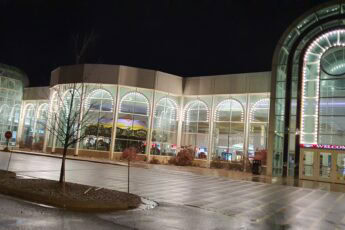Early Development and Opening
WestShore Plaza opened on September 28, 1967. Albert L. Manley of Boston, MA, developed it. The mall was Tampa’s first fully air-conditioned shopping center, making it a modern marvel for its time.
Maas Brothers, the first anchor store, opened on October 28, 1966, a year before the mall’s official opening. On the third floor, Maas Brothers featured the Suncoast Room Restaurant, complementing its flagship store in downtown Tampa.
JCPenney opened on September 7, 1967, as the second anchor. This store remains the only original anchor still in operation. The initial segment of the mall, connecting JCPenney and Maas Brothers, also opened at this time.
Woolworth’s, a five-and-dime store, was another notable tenant, along with Walgreens and Pantry Pride, a grocery store.
The first expansion occurred in 1974. A northeast wing was added, including a north parking garage and a third anchor, Robinson’s. Robinson’s sold its Florida stores to Maison Blanche in 1987, which then sold the store to Dillard’s in 1991. This expansion marked a period of growth and diversification for WestShore Plaza.
Dillard’s eventually moved to International Plaza and Bay Street, leaving a spot for Sears, which moved in from Tampa Bay Center in 2002.
WestShore Plaza also included other popular stores and amenities, establishing itself as a key retail destination in Tampa.
The mall’s development attracted shoppers and businesses, contributing to the commercial growth of the Westshore business district. For those looking for things to do in Tampa, FL, WestShore Plaza quickly became a go-to destination.
Changes in Ownership and Renovations
In 1990, the Grosvenor Group acquired WestShore Plaza, which led to a major renovation. They revamped the interior in a Spanish-Mediterranean style. The centerpiece was a three-story bell tower, adding a unique touch to the mall’s aesthetic.
Saks Fifth Avenue joined the lineup on November 12, 1998. However, they closed in 2013, and Dick’s Sporting Goods took over the space in 2014. The mall continued to evolve with these changes, adapting to new retail trends and consumer preferences.

The 2000s brought more updates. The food court moved to the former Pantry Pride building, making space for a new west wing.
This wing included a 14-screen AMC Theatres on the second level. These additions kept the mall relevant and appealing to a broad audience.
Restaurants like P.F. Chang’s China Bistro, Maggiano’s Little Italy, and Seasons 52 added to the dining scene. These spots became popular for both casual and special occasions. The blend of retail and dining made WestShore Plaza a versatile destination.
Washington Prime Group now owns and manages WestShore Plaza. Their stewardship has seen the mall through various changes.
From its early days with Maas Brothers to the latest expansions, WestShore Plaza has continually adapted to serve the community’s needs.
Decline and Store Closures
The retail landscape constantly changes, and WestShore Plaza felt these shifts. Sears closed its store in 2019 as part of a nationwide shutdown. This closure left a void but also opened opportunities for new developments.
JCPenney announced plans to close in 2020 but reversed the decision. This back-and-forth showed the challenges traditional retailers faced. Despite these hurdles, JCPenney remains a fixture at the mall, continuing to serve its loyal customers.
Other closures included The Palm restaurant, which shut down after over a decade in business. These closures marked the end of eras for some mall staples. Yet, the mall adapted by introducing new tenants and experiences.
Through these ups and downs, WestShore Plaza stayed resilient. The mall’s ability to adapt to retail trends and consumer needs helped it navigate these changes. The future looks promising, with new redevelopment plans on the horizon, aiming to transform the space while preserving its legacy.
Latest Developments at WestShore Plaza
WestShore Plaza in Tampa is set to undergo a massive redevelopment. In early 2024, the Tampa City Council approved plans to transform the aging mall into a mixed-use complex.
This approval marks a significant shift in the mall’s future, with the aim of revitalizing the space and better serving the community.
The redevelopment plan includes tearing down parts of the existing mall to make way for residential units, office spaces, and a hotel. Additionally, the project will feature new retail and restaurant spaces, ensuring the mall remains a central hub for shopping and dining.
The plans also include a recreational facility and a Hillsborough Area Regional Transit transfer bus station, which aim to enhance connectivity and accessibility.
Washington Prime Group, the current owner of WestShore Plaza, has yet to announce a specific timeline for the construction. However, approval for redevelopment is a crucial step forward. The project promises to breathe new life into the area, aligning with broader trends toward creating live-work-play environments in urban settings.
Several news sources have extensively covered the redevelopment project. Reports indicate that the mall’s current anchor, Macy’s, will remain while other parts of the mall will be demolished and rebuilt. This plan reflects the need to adapt to changing retail landscapes and consumer preferences.
The community has mixed reactions to the redevelopment. Some residents welcome the changes, seeing it as a much-needed update to a key area in Tampa.
Others express nostalgia for the mall in its current form. Despite these differing views, the redevelopment aims to modernize WestShore Plaza and ensure its relevance in the years to come.








